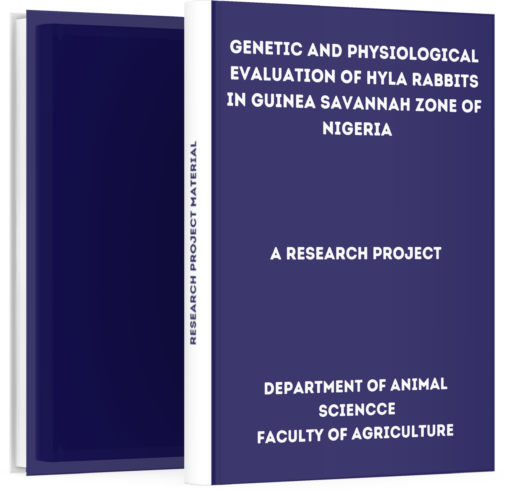Genetic and Physiological Evaluation of Hyla Rabbits in Guinea Savannah Zone of Nigeria
₦3,000.00
If you are interested in getting this project material “Genetic and Physiological Evaluation of Hyla Rabbits in Guinea Savannah Zone of Nigeria”, click on the DOWNLOAD BUTTON to make payment and the file will be delivered to your email immediately after confirmation.
Description
– Genetic and Physiological Evaluation of Hyla Rabbits in Guinea Savannah Zone of Nigeria –
Download Genetic and Physiological Evaluation of Hyla Rabbits in Guinea Savannah Zone of Nigeria. Students who are writing their projects can get this material to aid their research work.
Abstract
106 grand-parent Hyla rabbits of New Zealand (NZW) and California (CAW) breeds were imported from France consisting of 22 bucks of 11 NZW line (HYLA.GPC) and 11 CAW line (HYLA.MAX) and 84 does of NZW line (HYLA.NG).
They were mated naturally to produce two genetic groups consisting of 205 and 192 kits for Hyla purebred and crossbred respectively. 20 non-descript rabbits consisting of 12 old and 8 grower rabbits were used as control for the physiological evaluation.
Adaptability index were found to be proportionately moderate in Hyla New Zealand grand-parent (HNZW), Hyla California grand-parent (HCAW) and old non-descript (OND)(0.37,0.36and0.39)respectively. However values obtained for the F1 progeny lines and grower non descript were 0.34, 0.33 and 0.35forHylZealand (HNP),
Hyla New Zealand X Californian (NCP) and grower non-descript (GND). Genetic groups for both grand-parent and its FI progeny rabbits had significant (P < 0.05) influence on body-weights at all ages. Reproductive traits such as litter size at birth (LSB) to litter size at 35 (LS35),
litter weight at birth (LWB) to litter weight at 35 (LW35) were significantly (P < 0.05) higher for purebred than the crossbred Hyla rabbits. Individual kit weights were significantly (P < 0.05) higher for crossbred than the purebred rabbits at pre and post weaning ages.
Estimates of heritability (0.39 – 1.30), repeatability (0.21 – 0.77), and phenotypic correlations (0.28 – 1.00) were moderate to high, except for genetic correlations (0.09 – 0.87) which were low to high from birth through 35 days for pre weaning kit weights.
From the factor analysis, two principal components which accounted for 83.97 % of the total variance were extracted for Hyla purebred and three principal components accounted 89.88 % for Hyla crossbred rabbits.
In conclusion, the average performance of the Hyla rabbits was moderate and this implied gradual xx acclimatization to the tropical environment of Zaria. Heritability and repeatability estimates implied that progress will be faster through individual selection for the pre weaning traits.
The adaptability index should be further investigated to include more variables and larger sample size to improve accuracy of the estimates obtained.
Introduction
1.1 Background of the Study
Rabbits can be considered as one of the several species quite suitable for meat production. They are characterized by quality protein (20 – 21 % CP) with high biological value amino acids, meat low in calories and fat, prolificacy, short gestation length, initial capital outlay, great genetic flexibility, highly unsaturated lipids
(60 % of the total fatty acids), valuable animal model for biomedical research, low sodium and cholesterol. It is considered a delicacy for healthy food products (Dalle Zotte, 2002). However, the most obvious limitation to rabbit production in regions with hot climate is the susceptibility of this species to heat stress.
Heat stress, as indicated by elevated body temperature, occurs when environmental extremes, acute or chronic, lead to alteration in the rate of heat production and body temperature (Freeman, 1988). It occurs when animals are exposed to high ambient temperatures (30 – 39.5 oC), high humidity (60 – 90 %),
low wind speed and high direct and indirect solar radiation (Willmer et al., 2000). The importation of domestic animal diversity is essential to meet future needs in Nigeria due to the quest for protein sufficiency.
Also, this will be a suitable way to improve performance of our local rabbits by introducing purebred exotic rabbits with high growth and reproductive potentials. In semi-intensive and intensive systems, the rearing of more productive rabbit breeds could be a suitable path to improve the productivity and reduce the production cost.
Imported populations such as Hyla rabbits are usually bigger in size, have rapid growth, great adaptability, better reproductive efficiency and disease resistance. Hamouda et al. (1990) reported that Hyla rabbits are productive breeds used in many crossbreeding programs for genetic improvement.
2
Estimation of genetic parameters are primordial to the establishment of strategies to be used in Hyla rabbit breeding programs and the evaluation of response to selection for traits and genetic associations among traits (Nizza and Moniello, 2000).
Diversity that exists between Hyla breeds and our local breeds is likely to provide genetic combinations suited to a variety of environment and production systems in Nigeria. Genetic information on production traits for Hyla rabbits raised under the Guinea Savannah Zone of Nigeria is very limited
How to Download this Project Material
First, note that we are one of the best and most reliable online platforms because we don’t retain any of your personal information or data as regards making payments online.
PRICE: ₦3,500 ₦3,000 (Three Thousand Naira Only)
Make a bank deposit or mobile transfer of ₦2,000 only to the account given below;
Bank Name: UBA Account Number: 1022564031 Account Name: TMLT PRO SERVICES
After making the payment, CLICK HERE to send the following on WhatsApp;
- Depositor’s Name or Screenshot of Payment
- Name of the Past Question
- Active Email Address
or Call Us On +2348082284439 Once your details have been received and your payment confirmed by us, you will receive the past question in your email or WhatsApp within 5 Minutes.
Guarantee of Getting the Material
We understand that due to the high rate of fraud, many people are afraid of making purchases online but be rest assured that PastExamQuestions will deliver your material after payment.
Once your details have been received and your payment confirmed by us, you will receive the past question in your email or WhatsApp.
Give us Feedback
Have we been able to satisfy you? How well do you think the material will be helpful after having gone through it? Does the price worth the material?
Let’s hear from you! We recommend that our customers give feedback at the end of every transaction to enable us to serve better. You can do this by clicking the review button on this page.
Where is the review button? >> Just scroll up to where you see reviews





Reviews
There are no reviews yet.